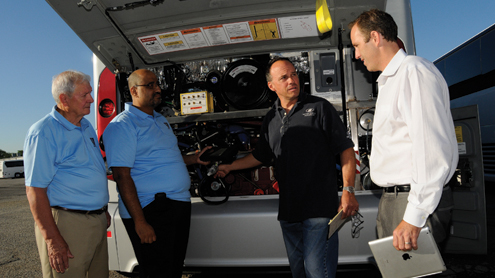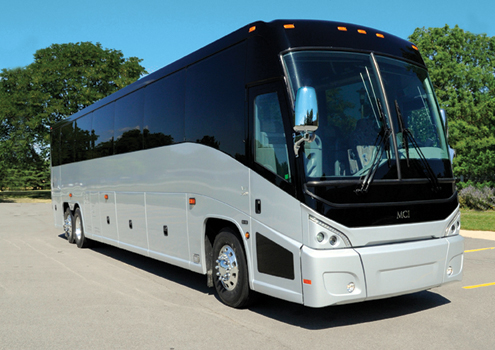

Peter Pan Bus Lines first to opt for stylistic and mechanical changes
By David Hubbard
Motor Coach Industries (MCI), Schaumburg, IL, made significant stylistic and mechanical changes this year to its stalwart MCI J4500 model for 2013. The redesign lends an up-to-date look and heightened curb appeal. MCI engineers collaborated with BMW Group Designworks USA, Newberry Park, CA, to make several key improvements to the lighting, body bumpers and serviceability.
BUSRide invited safety and maintenance expert Christopher Ferrone to test drive the new and improved J4500 and offer his comments. Based in Chicago, IL, Ferrone is president of Americoach Systems, Inc., and oversees maintenance and logistics for his family’s 106-year old bus transportation company, American Sightseeing.
“It’s natural to assume a new coach such as the MCI J4500 is going to look good and ride well, so I typically take a more a critical view,” he says. “My interests are in the engineering and construction, safety and maintenance elements, as well as ease for the driver, the mechanics and the passengers.”
The most pronounced changes are the redesigned front and rear fiberglass caps. The LED headlamps are now set in stainless steel to resist corrosion and sealed to reduce wind and air intrusion. The ID, clearance and marker lights are higher as well to enhance visibility and the coach’s nighttime profile.

“The change in the configuration of the bumper marker lights is notable,” says Ferrone. “I like the individualized lights. The giant bar that went across was hard to deal with and extremely expensive. Not only is this a better look, it is now possible to change out lights individually.”
The front RIM-injection molded high-energy bumper is now in three pieces, a center section and the two corners.
“I see this as an improvement,” says Ferrone. “As the corners of the bumper receive the greatest damage, they can be replaced with less expense.”
Electrical junction boxes front and rear house the ACTIA multiplexing.

“The new multiplex system in the J4500 is simple, well labeled and easy to read,” says Ferrone. “The clutter is gone with the number of boxes reduced to the fewest possible. Here’s the best part: This bus comes with its own hand-held diagnostic tool for the engine and transmission, which diagnoses the multiplex system as well.”
In the walk-around discussion before taking the coach on the road, something very simple caught Ferrone’s attention: the hinge on the front-left service door underneath the driver’s window.
“This is without doubt the coolest hinge I have ever seen,” says Ferrone. “To me this shows in a nutshell the cleverness and high-quality construction of MCI engineering. This is just an access door to the air tanks; only a mechanic would use it. Nonetheless, MCI custom built this hinge. It is not as if they went out and bought it. It has five different arms — all greaseable with ball bearings. That took some engineering, and to me this says a lot about the entire bus.”
Ferrone also commented on the baggage bay doors.
“I believe the average operator has to have components that are cost effective to repair and replace,” he says. “Where the bottom of baggage doors always seem to get take a beating. I noticed the replaceable rub rails on the door are now all one piece; meaning the entire panel has to be replaced if it is hit or damaged. By keeping this a sacrificial panel, it wouldn’t be as expensive to replace.”
“The J4500 has a great deal more access to the engine compartment than earlier models,” he says. “This is a big positive for technicians needing to work inside. They can get to a lot more components, which are more visible and reachable than before.”
From MCI headquarters, Ferrone and the MCI engineers boarded for a run to O’Hare International Airport as if to drop off passengers.
“Driving through a mixed residential and business area, I found this coach to be very stable,” he says. “I was able to make a fairly high speed lane change without what would be a lot of discomfort to the passengers or the driver. This coach has a good center of gravity and is very responsive, very maneuverable.”
Ferrone says the Cummins engine in this coach felt slow to respond and feels the Detroit Diesel is the better engine option. He commented positively on the response of the Allison Transmission.
Side-view cameras integrated into the review mirror’s head are another new option.
“A backup camera in each of the mirrors is great for the open highway, but I can see where they could be an expensive risk when driving several hundred miles a day in tight traffic,” says Ferrone. “I would be worried for the driver becoming distracted when seeing himself on the monitor. The TV screen in the driver’s area covers a portion of the windshield where it attaches, which I think impedes vision. I suppose it has advantages and disadvantages.”
Peter Pan Bus Lines, Springfield, MA, one of the largest privately owned coach operators in North America, runs a modern fleet of about 300 vehicles. The redesign of the 2013 J4500 impressed the company enough to be the first to place an order.
Every spring, Peter Pan replaces buses to maintain a modern fleet and finalize the next order.
“We’ve always liked the curb appeal of the J450, and even more so when MCI made us aware of the new features and options for the 2013 J4500,” says Peter Pan Chairman, Peter A. Picknelly. “We were able to weigh-in on what we liked and did not like and came back with what we saw as a go. The new design is a great fit into our existing 125 MCI J4500 coaches.”
Peter Pan takes delivery on the first of two coaches this fall.
“We are very pleased with the new look, particularly with the new headlight design,” he says. “I also think the wood trim in the entranceway will have strong customer appeal.”
From an operations standpoint, Tom Picknally, Peter Pan senior vice president, Maintenance, had a few practical observations.
“Running regular scheduled bus service in large metropolitan areas, the durability of our equipment is a continual challenge,” he says. “Graffiti is a fact of life. Graffiti invites more graffiti, it never ends.”
While the interior finish of the onboard restroom may not a glamorous improvement, it did get Picknally’s attention.
“This is what I mean by durability,” he says. “We can brush over graffiti with a slightly abrasive material and the markings wipe clean. It does not mar or harm the finish.”
Anything Tom Picknally would like to see?
“Something very simple,” he says. “While we are really pleased with how the new J4500 turned out, I would like to see an adequate trash receptacle in the front of the bus. It would greatly help the cleaning staff and make it more convenient for the passengers as they leave the bus.” BR

A comprehensive evaluation from experiened operators who maintain these vehicles once in service. Also it goes to show that while a Euro manufacturer was involved in the design, MCI did not sacrifice the strong engineering MCI is renowned for. Also the key features of an MCI coach remain: No useless overhang, maximum luggage capacity & strong road handling.
What needs to remain is the key feature of each window remaining a hinged emergency exit. Not the way Euro vehicles are built: Bonded side windows that require are hammer to break them open. Plus the high fibreglass content makes them highly fire prone.
It is reassuring to see that MCI has remained with its winning engineering formula.